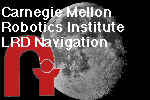 Details on the Navigation System
Details on the Navigation System Details on the Navigation System
Details on the Navigation SystemConcurrency is very important in achieving the levels of performance needed (1-2 Hz cycle time is desirable). In particular, perception and planning functions run simultaneously: while the obstacle avoidance planner is using one stereo elevation map to evaluate paths, the stereo system is processing another image. When stereo completes, it asynchronously sends the image to the planner. Likewise, the arbiter is getting asynchronous path evaluations from the planner and user interface, combining the most recent information to produce steering commands. Meanwhile, the controller module is receiving asynchronous commands and requests for pose information from different modules. While it is admittedly more difficult to develop and debug distributed, concurrent systems, they have great advantages in terms of real-time performance and modularity in design and implementation.



LRD Navigation Group - skoenig@cs.cmu.edu (last updated in March 1995)